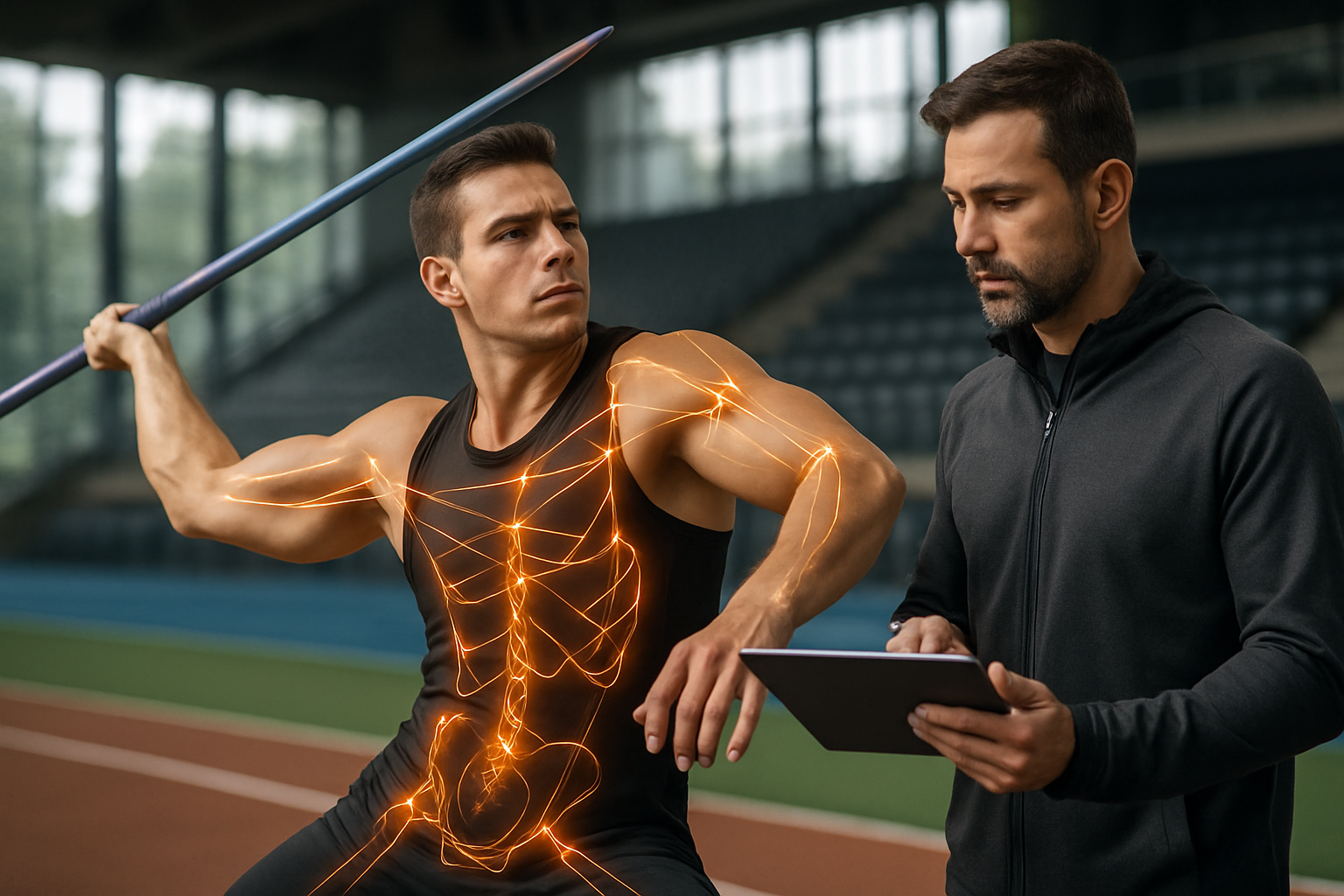The Biomechanics of Pole Vaulting: Soaring to New Heights
The rhythmic pounding of feet on the track builds to a crescendo as the pole vaulter charges forward, pole in hand. In a breathtaking display of strength, skill, and timing, the athlete plants the pole, bends it to its limits, and catapults skyward. This moment of flight, lasting mere seconds, is the culmination of years of training, precise technique, and a deep understanding of physics and biomechanics.

As the sport gained popularity, athletes and engineers sought ways to improve performance. The introduction of bamboo poles in the early 1900s allowed for greater flexibility and higher jumps. However, the real revolution came in the 1950s with the advent of fiberglass poles. These lightweight, flexible poles dramatically increased the potential height athletes could achieve, leading to a surge in world records.
Today’s pole vaulters use advanced carbon fiber poles, carefully tailored to their weight, speed, and technique. The sport has become a fascinating blend of athletics, physics, and engineering, pushing the boundaries of human performance to new heights.
The Physics Behind the Flight
At its core, pole vaulting is a study in energy transfer and conservation. The vaulter’s goal is to convert their horizontal kinetic energy from the run-up into vertical potential energy, propelling them over the bar. This process involves several key physical principles:
-
Kinetic Energy: The vaulter builds up speed during the approach, typically reaching velocities of 8-10 meters per second. This translates to a significant amount of kinetic energy.
-
Elastic Potential Energy: As the pole bends, it stores elastic potential energy, much like a spring being compressed.
-
Gravitational Potential Energy: As the vaulter rises, they gain gravitational potential energy.
-
Conservation of Energy: The total energy in the system remains constant, but it’s converted between different forms throughout the vault.
-
Torque and Angular Momentum: The vaulter’s body rotation during the vault is governed by principles of torque and conservation of angular momentum.
Understanding these principles is crucial for athletes and coaches looking to optimize performance. By maximizing the energy transfer from the run-up to the pole and then to the vaulter’s body, athletes can achieve greater heights and more consistent performance.
Biomechanical Analysis of the Vault
A successful pole vault can be broken down into several distinct phases, each with its own biomechanical considerations:
-
The Approach: The vaulter’s run-up is crucial for generating the necessary kinetic energy. Athletes must maintain an optimal speed while carrying the pole, which requires a specific running technique. Research has shown that the final two strides before planting the pole are particularly critical, with athletes making subtle adjustments to ensure proper foot placement.
-
The Plant and Take-off: As the vaulter plants the pole in the box, they must transfer their horizontal momentum into the pole while maintaining their forward velocity. This phase involves a complex interplay of forces between the vaulter, the pole, and the ground. Studies have shown that elite vaulters are able to minimize energy loss during this transition, effectively channeling their kinetic energy into bending the pole.
-
The Swing and Extension: As the pole bends, the vaulter swings their body upward and backward. This motion is crucial for positioning the body for the subsequent phases. Biomechanical analysis has revealed that successful vaulters maintain a straight arm position during the swing, maximizing the energy transfer from the pole to their body.
-
The Rock-back and Turn: As the pole straightens, the vaulter must quickly rotate their body to a vertical position. This phase requires precise timing and body control. Research using high-speed cameras and motion capture technology has shown that elite vaulters achieve a higher rock-back angle, allowing them to generate more vertical velocity.
-
The Push-off and Clearance: In the final phase, the vaulter pushes off the pole and clears the bar. The timing of the push-off is critical; pushing too early or too late can result in a failed attempt. Biomechanical studies have demonstrated that successful vaulters maintain a straight body position during the push-off, maximizing their vertical velocity.
Understanding these biomechanical principles allows coaches and athletes to develop targeted training programs and refine techniques for optimal performance.
Training Methodologies for Pole Vaulters
Given the complex nature of pole vaulting, training programs must address multiple aspects of athletic performance. Modern pole vault training typically includes:
-
Strength Training: Pole vaulters require significant upper body and core strength to control the pole and execute the vault. Exercises such as pull-ups, rope climbs, and gymnastics-inspired movements are common in vaulters’ strength routines.
-
Speed and Acceleration Training: The approach run is critical for generating the necessary kinetic energy. Sprinting drills, plyometrics, and resisted running exercises are used to develop explosive speed.
-
Technique Drills: Vaulters spend considerable time practicing individual components of the vault, such as the plant, swing, and turn. These drills often use specialized equipment like sliding boxes and suspended harnesses to allow for safe repetition of specific movements.
-
Gymnastics and Acrobatics: Many pole vaulters incorporate gymnastics training to improve body awareness, flexibility, and rotational skills. Exercises on the rings, high bar, and trampoline are particularly beneficial.
-
Mental Training: The psychological aspect of pole vaulting cannot be overlooked. Visualization techniques, mindfulness practices, and stress management strategies are often incorporated into training programs.
-
Video Analysis: Modern coaching heavily relies on video analysis to provide feedback on technique. Slow-motion replays and side-by-side comparisons with elite vaulters help athletes identify areas for improvement.
-
Biomechanical Assessment: Advanced training centers use motion capture technology and force plates to provide detailed biomechanical analysis of an athlete’s vault. This data can be used to fine-tune technique and identify potential injury risks.
These diverse training methods reflect the multifaceted nature of pole vaulting, combining elements of sprinting, gymnastics, and strength athletics into a single, explosive event.
Technological Advancements in Pole Vaulting
Technology has played a significant role in the evolution of pole vaulting, both in terms of equipment and training methodologies:
-
Pole Materials: The shift from rigid wooden poles to flexible fiberglass and carbon fiber composites has revolutionized the sport. Modern poles are engineered to match an athlete’s weight, speed, and grip height, allowing for optimal energy storage and release.
-
Landing Areas: Improvements in foam technology have led to safer, more forgiving landing areas. This has allowed vaulters to attempt higher jumps with reduced risk of injury.
-
Runway Surfaces: Advanced track surfaces provide better traction and energy return, allowing vaulters to generate more speed during their approach.
-
Wearable Technology: Some vaulters use wearable sensors during training to measure metrics such as approach speed, take-off angle, and body position throughout the vault.
-
Virtual Reality Training: VR systems are being developed to allow vaulters to practice their technique in a safe, controlled environment. This technology could be particularly useful for developing mental preparedness and spatial awareness.
-
3D Printing: Custom grip tape patterns and pole grips can now be 3D printed to match an athlete’s exact hand size and preferred texture, enhancing control during the vault.
-
Wind Tunnels: Some elite training facilities use wind tunnels to help vaulters optimize their body position for minimal air resistance during the clearance phase.
These technological advancements have not only improved performance but also enhanced safety and accessibility in the sport.
Injury Prevention and Management in Pole Vaulting
Despite improvements in equipment and training methodologies, pole vaulting remains a high-risk sport. Common injuries include:
-
Acute Injuries: Sprains, strains, and contusions from falls or impacts with the bar or landing area.
-
Overuse Injuries: Shoulder impingement, elbow tendinopathy, and lower back pain are common due to the repetitive nature of training.
-
Catastrophic Injuries: While rare, serious injuries can occur if a vaulter misses the landing area or the pole breaks during a vault.
To mitigate these risks, modern pole vaulting programs emphasize:
-
Proper Technique: Ensuring athletes master fundamental skills before attempting more advanced techniques.
-
Strength and Conditioning: Building a solid foundation of strength and flexibility to support the demands of vaulting.
-
Equipment Safety: Regular inspection and maintenance of poles, landing areas, and other equipment.
-
Progressive Training: Gradually increasing the difficulty of vaults to allow for proper adaptation.
-
Recovery and Regeneration: Implementing proper rest periods and recovery techniques to prevent overuse injuries.
-
Biomechanical Screening: Using motion analysis to identify potential technique flaws that could lead to injury.
-
Mental Preparation: Addressing the psychological aspects of the sport to reduce anxiety and improve focus, which can indirectly reduce injury risk.
By taking a comprehensive approach to injury prevention, coaches and athletes can help ensure longevity in the sport while pushing the boundaries of performance.
The Future of Pole Vaulting
As we look to the future, several trends are likely to shape the evolution of pole vaulting:
-
Biomechanical Optimization: Advances in motion capture technology and computer modeling will allow for even more precise analysis of vaulting technique. This could lead to the development of new, more efficient vaulting styles.
-
Genetic Insights: As our understanding of sports genetics improves, we may see more targeted talent identification and personalized training programs based on an athlete’s genetic profile.
-
Material Science: Continued advancements in pole materials could lead to even more responsive and durable poles, potentially enabling higher jumps.
-
Virtual Coaching: Remote coaching technologies may make expert instruction more accessible to vaulters around the world, democratizing access to high-level training.
-
Augmented Reality Training: AR systems could provide real-time feedback during training, allowing vaulters to make immediate adjustments to their technique.
-
Environmental Considerations: As climate change impacts outdoor sports, we may see more indoor vaulting facilities and adaptations to extreme weather conditions.
-
Rule Evolution: The sport’s governing bodies may need to consider how technological advancements impact competition fairness, potentially leading to new regulations.
These developments promise to keep pole vaulting at the forefront of athletic innovation, continually pushing the limits of human performance.
The Artistry and Science of Pole Vaulting
Pole vaulting stands as a testament to the incredible capabilities of the human body and mind. It is a sport that demands explosive power, precise technique, and unwavering courage. As we’ve explored, the seemingly simple act of propelling oneself over a high bar using a flexible pole is, in reality, a complex interplay of physics, biomechanics, and athletic skill.
From its humble origins as a practical means of navigation to its current status as an Olympic event, pole vaulting has continuously evolved. The introduction of new materials, training methodologies, and technological tools has allowed athletes to soar to heights that would have been unimaginable to early practitioners of the sport.
Yet, for all the scientific advancements and technical analysis, there remains an element of artistry to pole vaulting. The grace and fluidity of a perfectly executed vault can be as aesthetically pleasing as it is athletically impressive. It is this combination of raw power, technical precision, and artistic expression that continues to captivate athletes and spectators alike.
As we look to the future, pole vaulting is poised to continue its upward trajectory. With ongoing research into biomechanics, advances in material science, and the integration of cutting-edge technologies, we can expect to see even more remarkable performances in the years to come. However, at its core, the sport will always be a celebration of human potential – a dramatic display of our ability to defy gravity, if only for a moment, through sheer skill and determination.
For aspiring vaulters, coaches, and sports enthusiasts, the world of pole vaulting offers a rich field of study and practice. Whether you’re analyzing the physics of the vault, refining your technique, or simply marveling at the athleticism on display, pole vaulting provides a fascinating lens through which to view the intersection of science, technology, and human achievement.
As records continue to fall and new heights are reached, one thing remains certain: the pole vault will continue to inspire and amaze, pushing the boundaries of what we thought possible and reminding us of the extraordinary feats the human body can achieve when skill, science, and spirit come together in perfect harmony.





